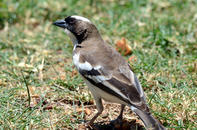
Name
White-browed sparrow-weaver (Plocepasser mahali)Appearance
The white-browed sparrow-weaver is a large sparrow-like weaver at around 17 cm in length. It has brown and white plumage, a conspicuous white stripe above the eye and two white wing bars. In flight, the white rump stands out. The white-browed sparrow-weaver has a dark bill.Diet
The white-browed sparrow-weaver is omnivorous and feeds on seeds, insects, fruit, seed pods, leaves and nectar.White-browed Sparrow-weaver Breeding
The white-browed sparrow-weaver is monogamous, co-operative and colonial. There are a single breeding male and female in each group. The breeding pair, assisted by the helpers, build an untidy straw like ball nest, with more than one entrance hole.
The second entrance will be closed when the nest is used for breeding. The female lays 2 to 3 eggs and incubates them alone for around 15 days. Only the female will feed the chicks for the first 3 days and she is then assisted by the male and the helpers.
Behaviour
White-browed sparrow-weavers live in groups between 2 and 11 birds. Each group will build its own nest with colonies being on average 16 nests, in a single tree. The nests are nearly always on the leeward side of a tree, between 2 and 8 m off the ground. Each group will have several nests, one for breeding and the others for roosting.Threats
The white-browed sparrow-weaver is of least concern.Distribution and Habitat
The white-browed sparrow-weaver is found in the northern half of South Africa, with a small population in the Eastern Cape, close to the town of Cradock. This bird is absent from the Lowveld and most of Limpopo Province.The white-browed sparrow-weaver is found in semi-arid acacia and mopane woodlands and is occasionally found in suburban gardens.